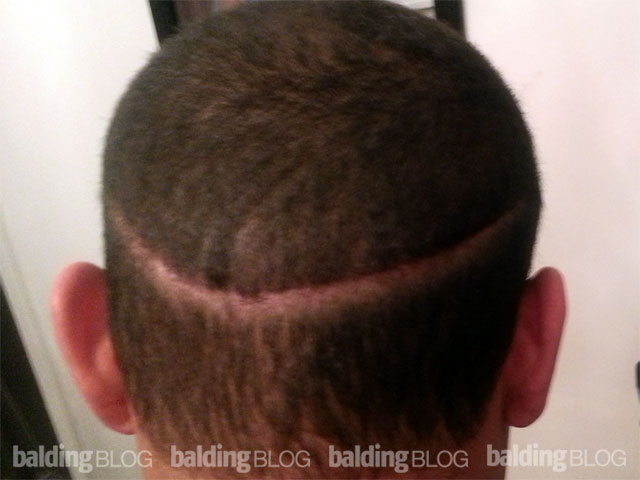Dear Dr. Rassman
I’m a 54 years old male. I had a hair transplant operation on 30 June 2013 by FUT method followed by FIT method on 1st July to complete the transplantation. From the second day after operation I noticed that a big area in recipient part between crown and front of my head, the skin is so irritated (fig.1) and after 1 week it became completely black and was necrosed (fig.2).
Photos: Figure 1, Figure 2
I rang to my surgeon to consult on this issue. He said at your age this problem sometimes happens and I should wait until the skin being repaired and to speed up this procedure I should put warm towel on the necrosis area as well as making it oily by Vaseline to avoid dryness. I really don’t believe in the opinion of my doctor to relate this problem to my age, so I would highly appreciate if you let me know your opinion regarding the reason of this problem, is there any special treatment for such necrosis?
As the recovery procedure of the skin is so slow as shown in figs 3 and 4, I’m not sure that the transplanted follicles are not damaged. I thank you so much if receiving your valuable comments.
Photos: Figure 3, Figure 4
Sincerely yours

I am not clear on your history as you note a FUT (as in strip surgery) and FIT (as in Follicular Isolation Technique). There are some doctors who combined FUT and FUE (called FIT by one particular surgeon).
In my 23 years in this industry, we have performed hair restoration surgery in over 15,000 patients (with as many as 8 doctors working for the New Hair Institute at one time), so my experience is in the thousands of patients we have treated at NHI. Although I have never personally seen this complication in any patient that I have treated, I have been aware of this complication in patients who have either consulted with me or I have heard about it through other doctors’ reports at medical meetings. This problem was more common in the 1993-1996 time frame, as doctors were increasing the number of grafts they were performing and not reducing the size of the punch or slit equipment. These doctors devascularized the scalp because their wound areas were too large. Based upon this, I have assumed that the blood supply was negatively impacted for this problem.
The central area of the scalp (where your problem is demonstrated) was the place where this complication has been seen. The least vascular area of the head is probably at that exact location. As you may know, balding produces an atrophic skin that is thin and not vascular with little infrastructure (fat) under the skin (where a normal scalp would be rich in blood supply, with many nerves per follicle, many hair follicles, considerable amounts of fat, etc..). The reason that the skin becomes atrophic in balding men is because the bald scalp does not need a rich blood supply, so the body withdraws the blood vessels in response to lack of demand. When a hair transplant is done, the demand of the new hair increases the blood supply and eventually the scalp is no longer atrophic and becomes rich in blood supply again.
I am certain that age is not an issue. My oldest patients have been in their 80’s and we routinely operate on men in their 60s and 70s. I have done surgery on diabetics and in these people, I have not seen vascular problems either, but I often do not ‘dense pack’ these diabetic people for fear of such a complication. I personally had a hair transplant last year (at the age of 70) with no issue. I had an atrophic scalp resulting from 3 scalp reductions done in 1991-1992 that left my skin very, very thin and atrophic, yet I suffered no vascular effects from the transplant into my atrophic skin.
Some doctors believe that there is a risk for people who smoke, so if you are an active smoker, then this could be a contributing factor. If your surgeon used instruments that were larger than 18 gauge needles, then this could be a contributing factor. I have also seen necrosis when the doctor accidentally switched the routine medications used for anesthesia from a benign medication to a toxic medication; however, yours does not appear drug induced, because the necrosis would have been more immediate than your earlier pictures showed.
My educated guess is that there was a blood supply issue to the top of the scalp where blood supply is reduced in atrophic skin (something that you probably had). How that happened is unclear.
The treatment for this type of problem could be a problem. Usually, small areas of necrosis shed the dead skin and the wounds heal from the sides; however, large areas of necrosis puts you at risk for damage to the skull, so an experienced surgeon who knows of such risks should be consulted.
Please note that what I have stated here is NOT to be taken as a second medical opinion, but just an informational view from a well informed and experienced hair restoration surgeon. To evolve this into a formal second opinion, I would have to personally see you and examine you. If you would like a second medical opinion, please find and see a physician in person.


